捷克佳/早就听说这里要开一间Wal-Mart店,不时路过也看见店面总是在装修,便以为开张的日子尚远。但昨晚日大雨中却突然发现,诺大的停车场已经被汽车占满。于是,今日前往探个究竟。走近才发现,这是一间Wal-Mart超级店(SuperStore),主色调颜色是柔和的土黄色和咖啡色,而不是Wal-Mart传统的红蓝两色。
路边的一个宣传条幅上书“祝贺Wal-Mart第300家店面开张!”300这个数字究竟代表什么?它在美国50个州店面的数字肯定超过300,因为十多年前在美国时,几乎每个城镇都至少有一间店面,大的城市还有Wal-Mart SuperStore和Sam’s Club,不少都是24小时营业。按安省和大多伦多地区推算,全国应该有百余家店,便想当然地以为这个数字可能是Wal-Mart超级店的第300间。但在商店中问询一位部门经理才知道,这是Wal-Mart在加拿大的第300家店面!
查阅Wal-Mart Canada的网站获知,这间位于密西沙家市Heartland购物区的店面是周三(6月11日)正式开张,当日上午还举行剪彩仪式。同一日稍后,位于阿尔伯塔省的第301间店面亦将开张。没有想到,Wal-Mart在加拿大的扩张速度真是惊人。
密西沙家市Heartland购物区可谓商家的必争之地,加拿大第一家BestBuy便是在这里设店,然后在全国扩张。这里也是不少商家的滑铁卢,CompuSmart便因业绩不佳败下阵来。这里的各类商家较为齐全,BestBuy,Futureshop(隶属于BestBuy,并与之相隔不远),Costco,Canadian Tire,HomeDepot,Rona,Lablaw等等。这间新开张的Wal-Mart旗舰店(flagship)估计是想方设法吸引顾客,营业的时间是每日上午6时至晚12点,想必是恨不能从顾客的口袋中掏钱。
Wal-Mart Canada是在1994年3月在加拿大创立,当年,收购经营艰难的122间Woolco 连锁店,并在8个月内全部转为Wal-Mart的格式。目前,Wal-Mart 在加拿大是第4大雇主企业,雇用员工人数超过75000人。
Wal-Mart公司由美国零售业的传奇人物山姆·沃尔顿(Sam Walton )于1962年在阿肯色州成立。经过四十多年的发展,沃尔玛公司已经成为美国最大的私人雇主和世界上最大的连锁最大零售企业目前,沃尔玛在全球开设了6,600多家商场,员工总数180多万人,分布在全球14个国家。每周光临沃尔玛的顾客1.75亿人次。沃尔玛(WAL-MART)是全球500强榜首企业。
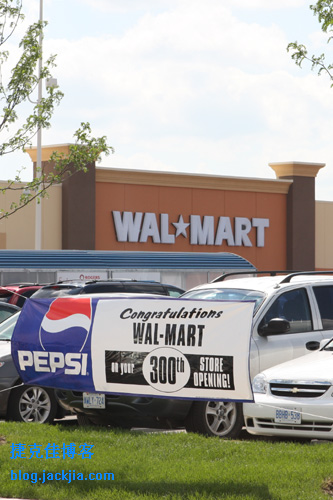
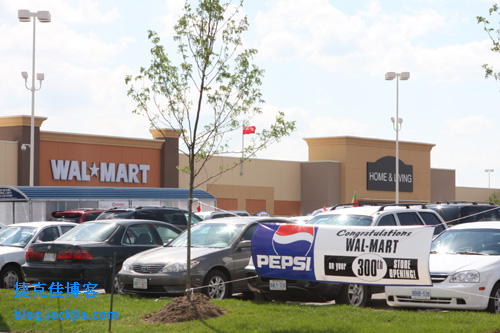
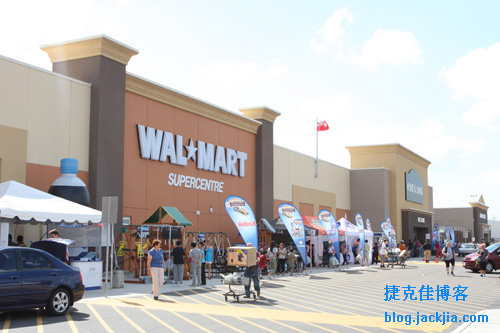
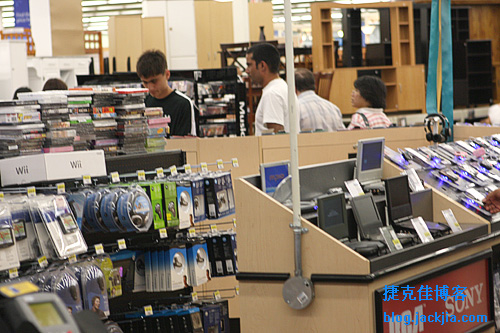

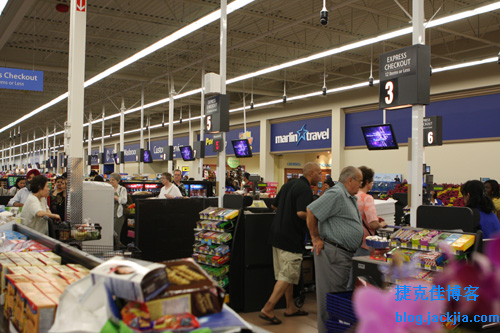
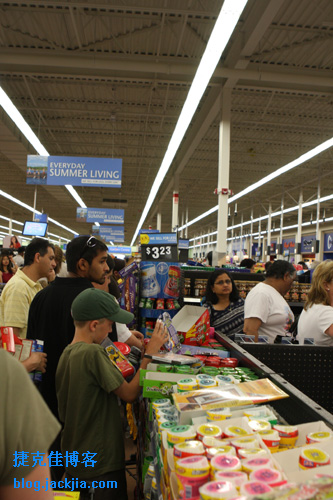
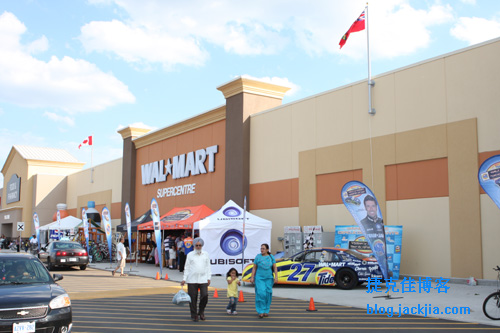
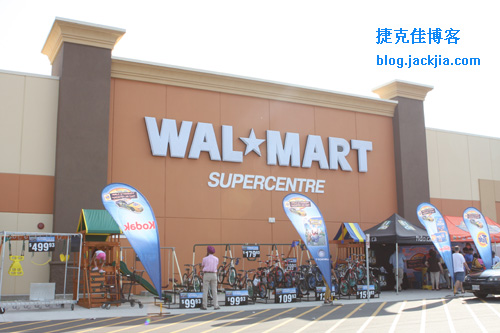
News Releases: Wal-Mart Canada unveils 300th store
New CEO, Cheesewright: Company is “better than ever” on the promises of price and selection.
MISSISSAUGA, ON, June 11 /CNW/ – Wal-Mart Canada opened the doors of its 300th store this morning, a Wal-Mart Supercentre in the Heartland retail district of Mississauga, Ontario. The flagship store welcomed thousands of customers in the first hour of operation – including a line up of hundreds waiting for the 8 a.m. ribbon cutting.
“Wal-Mart Canada is a strong business getting stronger,” said David Cheesewright, Wal-Mart Canada’s president and CEO, during grand-opening remarks at the 300th store this morning. “As we get ready to open the doors of our 300th store here in Mississauga, our 301st store is scheduled to open later this morning in Peace River, Alberta. Demand for our stores is high and we are responding.”
The continued growth of Wal-Mart Canada’s business – including as many as 27 new or expanded stores planned nationwide for the current year – is built upon a foundation begun in 1994, when Wal-Mart Canada took over operations of a struggling chain of 122 Woolco stores. Since that time the company has constructed 255 additional or relocated stores and expanded 28 stores, investing several billion dollars into the local economy and creating approximately 100,000 in-store and construction trade jobs.
“Wal-Mart is a business of progress and opportunity,” said Cheesewright.
“Our chain is growing, our team is growing, and the opportunities to be part of a business at its best are growing.” As the fourth-largest employer in Canada, with a growing team of more than 75,000 associates, the company estimates that the equivalent of one in 100 Canadians has at some point worked for Wal-Mart. New format Wal-Mart Supercentres, require larger teams of associates and management – a team of more than 500 in the case of the newly opened 300th store, which received more than 3,500 job applications.
Supercentres also offer a larger assortment of merchandise, combining Wal-Mart’s traditionally strong general-merchandise selection with a full assortment of groceries. Canada’s first three Wal-Mart Supercentres opened in Ontario in October, 2006. By day’s end there will be 34 in three provinces – Ontario, Alberta and British Columbia.
In Supercentres and across its entire chain, Wal-Mart Canada has made significant improvements to its customers’ shopping experience and to its customers’ favourite departments. Over the course of the past two years, the company has revitalized and made major changes to departments like fashion, electronics, home and housewares, health and beauty, and groceries.
“The evolution of our business has caught the attention of our customers and led Canadians to become even more enthusiastic Wal-Mart shoppers,” said Cheesewright. “Our numbers show that about one in 30 Canadians walk through our doors every day – and 95 per cent of those with access to a Wal-Mart store visit us at least once every few months.”
Wal-Mart Canada proudly introduced the concept of Everyday Low Prices to the Canadian marketplace in 1994, ensuring that Canadians wouldn’t have to wait for sales, rebates or gimmicks to get the lowest prices on well-known national brands. Fourteen years later, the company remains committed to giving customers the products they want at the lowest prices.
“Retailers generally find their strength by committing to one or two priorities,” said Cheesewright. “Our strength has been the promise of price and selection. On those measures, we’re better than ever and focused on continuous improvement. Fourteen years into our evolution our new stores offer customers three times the selection we had in 1994, and we’re more committed than ever to saving Canadians money so they can live better. In fact, this year is a record year for our famous ‘Rollback’ price cuts. In many ways, we’re just hitting our stride.”
In addition to the core strategies of price and selection, Wal-Mart Canada’s 300th store illustrates various evolutionary changes to the company’s business:
Sustainability: The 300th store includes reduced wattage and LED lighting technology; higher efficiency systems for heating, ventilation, air conditioning, and sales floor refrigeration; waste diversion and recycling programs; more environmentally friendly construction materials like reflective roofing and chemical-free concrete flooring; and a full assortment of eco-friendly merchandise from bamboo apparel, to 250 organic grocery items, to efficient CFL bulbs with fully recycled and recyclable packaging.
Store of the community: The 300th store is located in Mississauga, Ontario, serving the most ethnically diverse market of any Wal-Mart store nationwide. The need for Wal-Mart’s “store of the community” approach – providing services and products that reflect the tastes and traditions of the local populations – is particularly appropriate in this market. The store’s welcome sign includes script in nine different dialects and merchandise has been stocked to serve various cultural and ethnic tastes. For example, the store stocks Halal tandoori rostiserie chicken, Punjab biscuits, 20 different grains of rice, cricket sports equipment, various housewares, and Bollywood-inspired movies and fashions, for the approximately 16 per cent of the local customers who identify themselves as South Asian.
Store appearance and operations: From refreshed colours to new in-store signage, the 300th store has a different appearance to prior stores, representing a massive departure from the gray box stores of 1994. Single-line queues with multiple cash registers, enhancements to the electronics department to provide greater high-tech assistance, aisles widths, and new “find the price here” price-check stations, all indicate a new and increased attention to customer service.
About Wal-Mart Canada: Founded in 1994 and based in Mississauga, Ontario, the company serves more than one million Canadians each day at 301 stores and six Sam’s Club locations. With more than 75,000 associates, the company is one of Canada’s largest employers and has repeatedly listed among the 50 Best Companies to Work for in Canada, as published in Report on Business Magazine.
http://micro.newswire.ca/release.cgi?rkey=1606112542&view=73403-0&Start=0
Company Profile
Wal-Mart Canada was founded in March of 1994 with the acquisition of the Woolco division of Woolworth Canada Inc. A total of 122 Woolco stores were converted in less than eight months to the Wal-Mart format.
Today, the Wal-Mart Canada Home Office is located in Mississauga, Ontario, with over 278 locations employing more than 70,000 Canadians. Petitions continue to come in from across Canada asking that Wal-Mart stores be built in their towns. Wal-Mart Canada will continue to open new stores and make changes to better serve its customers.
Each Wal-Mart store across Canada offers top quality merchandise and services. Every store houses close to 80,000 different products. Merchandise includes apparel, home fashions, household goods, toys, hardware, paint, wallpaper, automotive accessories, electronics, sporting goods, furniture, horticulture, cosmetics, jewellery, and convenient food items. Our listing of services are described in the Special Products and Services section.
Wal-Mart is committed to giving Canadians the best shopping experience in the marketplace.
http://walmart.ca/wps-portal/storelocator/Canada-About_Walmart.jsp
1 Comment
Leave a Comment
要发表评论,您必须先登录。


History Timeline
1960s
The Wal-Mart story began in 1962, when Sam Walton opened the company’s first discount store in Rogers, Ark. Five years later, there were 24 Wal-Mart stores in Arkansas ringing up $12.6 million in sales. 1968 saw the hiring of Wal-Mart Aviation’s first full-pilot, who provided help to Sam and Bud Walton, as well as the opening of the first stores outside of Arkansas, in Sikeston, Mo., and Claremore, Okla. The company officially incorporated as Wal-Mart Stores Inc. on October 31, 1969.
1970s
The 1970s marked the beginning of significant growth for the company. The first year of that decade saw the opening of the first Wal-Mart distribution center, as well as the Wal-Mart Home Office, in Bentonville. Ark. At that point, Wal-Mart employed 1,500 Associates working in 38 stores, with sales of $44.2 million. Wal-Mart also began selling shares over the counter as a publicly-held company in 1970.
In May 1971, Wal-Mart stock experienced its first 100 percent split, at a market price of $47. At that time, the company operated in five states: Arkansas, Kansas, Louisiana, Missouri and Oklahoma. In 1972, after being approved and listed on the New York Stock Exchange, Wal-Mart stock split 100 percent for a second time, with a market price of $47.50. The company then expanded into three more states, entering Tennessee in 1973 and Kentucky and Mississippi in 1974.
By the middle of the decade, Wal-Mart employed more than 7,500 associates in 125 stores with sales of $340.3 million, and in 1975 entered into the state of Texas. Wal-Mart stock split for the third time in August of that same year, with a market price of $24, and the company made its first acquisition, taking control of 16 Mohr-Value stores in Michigan and Illinois. 1975 was also the year that Sam Walton, inspired by workers he encountered during a visit to Korea, conceived of the famous “Wal-Mart Cheer” and introduced it to his associates.
Wal-Mart began operating in Illinois, its 10th state, in 1977. The next year, the company acquired the Hutcheson Shoe Company, and introduced the Wal-Mart pharmacy, auto service center and jewelry divisions. In 1979, Wal-Mart became the first company to reach $1 billion in sales in such a short period of time. The company closed out the decade with 276 stores, 21,000 associates and $1.248 billion in sales, and the addition of its 11th state, Alabama.
1980s
Growth continued into 1980, with Wal-Mart stock splitting 100 percent for the fourth time with a market price of $50. That year also saw the opening of the largest distribution center to date in Palestine, Texas. In 1981, Wal-Mart entered Georgia and South Carolina, and made its second acquisition with 92 Kuhn’s Big K stores. The company entered Florida and Nebraska in 1982, following June’s fifth 100 percent stock split at a market price of $49.875.
Forbes magazine ranked Wal-Mart No. 1 among general retailers for the eighth year straight in 1983, the year that the first Sam’s Club opened in Midwest City, Okla. The same year, Wal-Mart opened stores in Indiana, Iowa, New Mexico and North Carolina, implemented the characteristic People Greeters in all locations, and opened the first 1-hour photo lab in Tulsa, Okla. Wal-Mart also acquired U.S. Woolco Stores in 1983, and the stock split 100 percent for the sixth time with a market price of $81.625.
1984 saw Sam Walton doing the hula at high noon on Wall Street, making good on a promise to associates after the company achieved a pre-tax profit of 8 percent for the previous fiscal year. 1984 was also the year that David Glass was named company president, and Wal-Mart entered Virginia.
At mid-decade, Wal-Mart employed 104,000 associates in 882 stores with sales of $8.4 billion. Stock split 100 percent in September, with a market price of $49.75. That year, the company entered Wisconsin and Colorado and also acquired Grand Central Shoes. The next year, 1986, Wal-Mart entered Minnesota.
Wal-Mart marked its 25th anniversary in 1987, with 1,198 stores, sales of $15.9 billion and 200,000 associates. The stock split 100 percent again in June, with a market price of $66.625. The company also completed the Wal-Mart Satellite Network, the largest private satellite communication system in the United States, linking all operating units of the company and the Home Office with two-way voice, data, and one-way video communication.
By 1988, 99 percent of Wal-Mart stores had bar-code scanning capabilities, the first Supercenter opened in Washington, Mo., and the company acquired Supersaver units. David Glass was named chief executive officer of Wal-Mart Stores, Inc. Wal-Mart closed out the 1980s with the addition of operations in Michigan, West Virginia, and Wyoming, for a total of 29 states.
1990s
Wal-Mart became the nation’s No. 1 retailer in 1990, entering into California, Nevada, North Dakota, Pennsylvania, South Dakota, and Utah and acquiring the McLane Company of Temple, Texas. The company also opened the Wal-Mart Visitor’s Center on Bentonville’s town square, on the site of Sam Walton’s original Walton’s 5-10 store. Wal-Mart stock split 100 percent for the ninth time in 1990 as well, at a market price of $62.50.
Branching out further in 1991, Wal-Mart stepped into the international market with the opening of a retail unit in Mexico City. On the domestic front, the company entered into several states in the Northeast and South Atlantic regions, including Connecticut, Delaware, Maine, Maryland, Massachusetts, New Hampshire, New Jersey and New York, and acquired Western Merchandisers, Inc. of Amarillo, Texas. Wal-Mart also introduced the “Sam’s American Choice” brand products in 1991.
On April 5, 1992, Sam Walton passed away at the age of 74. Just weeks before, President George H.W. Bush presented him with the Medal of Freedom, the nation’s highest civilian honor during a ceremony at Wal-Mart headquarters. Following Sam’s passing, his son S. Robson Walton was named chairman of the board. With the additions of Idaho, Montana and Oregon, Wal-Mart operated in 45 states in the United States in 1992, and expanded into Puerto Rico.
Wal-Mart’s international business formed its own division the following year, with Bobby Martin serving as president. 1993 also saw the tenth 100 percent stock split at a market value of $63.625; the first billion-dollar sales week in December; the acquisition of 91 Pace Warehouse Clubs; and Wal-Mart’s entry into Alaska, Hawaii, Rhode Island and Washington, bringing the company’s total to 49 states. The 50th would be added two years later.
In 1994, a prototype Wal-Mart store, designed to be as environmentally friendly as possible, opened in Lawrence, Kan. The company acquired 122 Woolco stores in Canada, and opened three value clubs in Hong Kong. As of that year, Wal-Mart International operated 123 stores in Canada and 86 in Mexico. Also in 1994, the Code Adam missing child program was implemented in all stores, being named for Adam Walsh.
1995 saw the passing of Sam Walton’s brother, James Lawrence “Bud” Walton, Wal-Mart’s co-founder. The company entered its 50th state, Vermont, and built three units in Argentina and five in Brazil. As of that year, Wal-Mart Stores Inc. operated 1,995 stores, 239 Supercenters, 433 Sam’s Clubs and 276 international stores with sales of $93.6 billion and 675,000 associates. In 1996, Wal-Mart entered China through a joint-venture agreement.
By the following year, Wal-Mart became the largest private employer in the United States with 680,000 associates, plus an additional 115,000 international associates. 1997 was also Wal-Mart’s first $100 billion sales year, with sales totaling $105 billion, and the company served 90 million customers per week worldwide. Wal-Mart also replaced Woolworth on the Dow Jones Industrial Average, and the company introduced OneSource nutrition centers.
Wal-Mart entered into two more countries in 1998, with the acquisition of 21 Wertkauf units in Germany and a joint-venture agreement to operate in Korea. The company exceeded $100 million in annual charitable contributions that year, with donations totaling $102 million. Wal-Mart also introduced the Neighborhood Market concept with three stores in Arkansas.
In the last year of the 1990s, Wal-Mart became the largest private employer in the world, with 1,140,000 total associates. The stock split 100 percent for the 11th time, with a market price of $89.75. The 1999 Cone/Roper Report, an annual national survey on philanthropy and corporate citizenship, ranked Wal-Mart the No. 1 Corporate Citizen in America. The company acquired 71 Interspar units in Germany and acquired the ASDA Group plc in the United Kingdom.
2000s
Wal-Mart entered the new millennium with the appointment of H. Lee Scott Jr. as the third CEO of Wal-Mart Stores Inc. in 2000. That same year, Fortune magazine ranked the company fifth in its “Global Most Admired All-Stars” list and named Wal-Mart the third most admired company in America. The 2000 Cone/Roper Report once again ranked Wal-Mart as the No. 1 Corporate Citizen in America.
Hispanic Business magazine ranked Wal-Mart one of the “Top 25 Diversity Recruitment Programs” in 2001 for its aggressive program to hire and promote Latinos. In 2002, Wal-Mart received the 2002 Ron Brown Award, the highest Presidential Award recognizing outstanding achievement in employee relations and community initiatives.
Fortune magazine also placed Wal-Mart in the top spot on its “Most Admired Companies” list two years in a row, in 2003 and 2004. In 2004, Wal-Mart was also presented the “Corporate Patriotism Award,” which is presented to a company that exhibits exceptional dedication to supporting of U.S. service members and their families.
Wal-Mart marked a significant turning point in 2005 with a new commitment to bring environmental sustainability into its business, under the leadership of CEO Lee Scott. The sustainability commitment developed after Wal-Mart lead the corporate drive to assist in U.S. hurricane relief efforts with $18 million in cash donations. That same year, in McKinney, Texas, and Aurora, Colo., Wal-Mart created experimental stores that save energy, conserve natural resources, and reduce pollution. The company also launched the Acres for America program, which conserves critical wildlife habitats for future generations.
As of 2005, Wal-Mart employed more than 1.6 million associates in more 6,200 facilities around the world – including 3,800 U.S. stores and 3,800 international units – with $312.4 billion in sales for the year. The company served more than 138 million weekly customers in the United States, Argentina, Brazil, Canada, China, Costa Rica, El Salvador, Germany, Guatemala, Honduras, Japan, Mexico, Nicaragua, Puerto Rico, South Korea and the United Kingdom.
By 2006, the number of weekly customers grew to more than 176 million around the world, with 6,779 locations. Wal-Mart had record net sales of $345 billion. The company increased its ownership stake in Seiyu in Japan, to 53.3 percent, and increased its ownership of CARHCO to 51 percent, renaming the company Wal-Mart Central America.
Through the Wal-Mart Foundation, charitable partners, and donations from customers and associates, Wal-Mart contributed more than $415 million in cash and in-kind merchandise to 100,000 organizations worldwide. Wal-Mart also launched a new $4 generic prescription drug program to help customers in its U.S. pharmacies save money on health care.
In February 2007 Wal-Mart helped launch Better Health Care Together, a unique partnership of organizations dedicated to a set of four common sense principles for achieving a new American health care system by 2012. Later in the year, Wal-Mart expanded its successful $4 generic program, which as of 2007 had saved customers more than $396 million on prescription drug costs.
Wal-Mart International reached significant milestones as well. In August, Wal-Mart and Bharti Enterprises announced an agreement to establish Bharti Wal-Mart Private Limited, a joint venture for wholesale cash-and-carry and back-end supply chain management operations in India.
The 3000th international store, a Supercenter in Sao Paulo, Brazil, opened in November 2007. In December, Wal-Mart successfully completed a tender offer to acquire all issued and outstanding shares of Seiyu in Japan, which raised Wal-Mart’s ownership to 95.1 percent.
http://walmartstores.com/AboutUs/7603.aspx